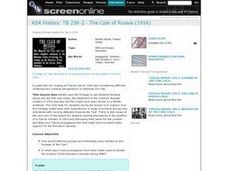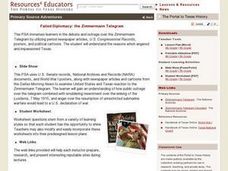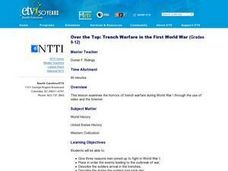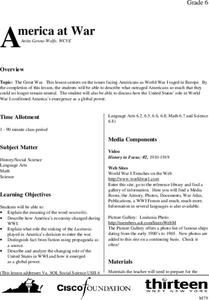Facing History and Ourselves
We and They, the Armenians in the Ottoman Empire
Learners examine World War I war crimes. For this world history instructional activity, high schoolers use primary and secondary sources to research and understand the action taken by the United States during the Armenian Genocide....
Facing History and Ourselves
The Range of Choices
Learners examine crimes against human rights. In this world history instructional activity, students watch a segment of a video about the Armenian Genocide. Learners reflect on the crimes of the Ottoman government in classroom...
Facing History and Ourselves
What is Justice After Genocide?
Students explore the meaning and implications of genocide. In this human rights lesson plan, students investigate the Aremenian genocide that took place in Turkey and the subsequent trials of the leader of the genocide held by the...
Facing History and Ourselves
American Responses to the Armenian Genocide
Young scholars examine World War I war crimes. In this world history instructional activity, students use primary and secondary sources to research and understand the action taken by the United States during the Armenian Genocide. Young...
Curated OER
Wilson and American Entry into World War I
Students explore the events that led to American entry into World War I. In this American history lesson plan, students examine the policies of Woodrow Wilson at the dawn of the war, analyze challenges to the neutrality policy of the...
Stanford University
Sedition in World War I
Students examine the critics of the First World War. In World War I instructional activity, students free write about patriotism and determine its meaning. After watching a video students discuss patriotism and opposition to the war....
Curated OER
Lines From Behind the Lines
Fifth graders create a timeline of events in a soldiers life. In this World War I lesson, 5th graders learn about the Great Depression and World War I. Students watch video segments about World War I and examine primary sources from...
Facing History and Ourselves
Analyzing Historical Evidence
High schoolers examine World War I war crimes. In this world history instructional activity, students use primary and secondary sources to research and understand the systematic nature of the Armenian Genocide. High schoolers reflect on...
Curated OER
Statistics Related to the First World War
In this history and probability worksheet, students examine a chart of statistics associated with World War I which include total of men in the war by nation, number of deaths, and number of men taken prisoner. They answer 5 questions...
Curated OER
TB - Lusitania Day (1916)
Students, after brainstorming all the different types of propaganda, explore, analyze and study the nature, origin and purpose of propaganda and how its aims are achieved. They assess how the sinking of the Lusitania was manipulated by...
Curated OER
WWI and Russian Revolution
Students view and discuss footage of Tsar Nicholas II reviewing troops on the Eastern Front in 1916 and examine how different groups would have reacted to this footage of the Tsar. They watch the video and in small groups answer...
Curated OER
Failed Diplomacy: The Zimmerman Telegram
Seventh graders continue their examination of World War I. In groups, they read a copy of the famous Zimmerman telegram and discuss its effect on Americans. To end the lesson, they discuss how public opinion changed after it became...
Curated OER
Enemy or Ally: America's Response to the Russian Revolution
Learners examine the events related to the Russian Revolution. In groups, they use the internet to discover the concerns of Woodrow Wilson during this time period and relate them to the origins of the Cold War. To end the lesson, they...
Curated OER
World War I
Eighth graders examine the condition of the world from 1880 until the start of World War I. After watching a PowerPoint presentation, they discuss the causes and effects of the war and complete a study guide with a partner. To end the...
Curated OER
To War Or Not To War?
Seventh graders research the political, societal, and economic factors of World War I, World War II, and the 2001 war against terrorism. They participate in class discussions, write journal entries, and conduct Internet research. ...
Curated OER
World War I: War in a Democratic Society
Students research opposition and support for World War I from a number of perspectives. They analyze a number of primary and secondary sources, while considering what (if anything) makes a war just and write a letter expressing his/her...
Curated OER
World War I
High schoolers justify how alliances lead to war. They compare the conflicts of war that arose because of imperialist interest. Students explain the cause of World War I. They compare and contrast European maps before and after World...
Curated OER
Over the Top: Trench Warfare in the First World War
Students are able to give three reasons men joined up to fight in World War I. They are able to place in order the event leading to the outbreak of war and describe the soldiers arrival in the trenches. Students are able to describe...
Curated OER
Two World Wars
Learners listen to a lecture about WWI, or they go through the WWI project time line in a computer center. Students repeat the above options about WWII. Once the research is complete, learners compare the two wars by filling in the...
Curated OER
Paris Peace Conference: Writing a Treaty to End World War I
How did World War I end? Tenth graders role play as experts from countries that were involved in World War I. They write a treaty to end the war and compare it to the Treaty of Versailles.
Curated OER
World War One Newscast
Middle schoolers complete research on the causes, battles, weapons, leaders and results of World War One and use the information to create Newscasts of the topics. These newscasts are then presented to the class.
Curated OER
America at War
Sixth graders examine issues that faced Americans during World War I, discuss role that sinking of the Lusitania had in America's decision to enter the war, and analyze changing role of U.S. during the war and how it emerged as a world...
Curated OER
Lesson 4. Killing Fields
Eleventh graders describe several of the WWI's bloodiest battles, track the battles' progression to determine advances made by leading nations, and write frontline journalistic accounts of one or more of the battles.
Curated OER
The Legacy of the "Great War"
Students study how the map of Europe changed as a result of the Treaty of Versailles at the end of World War I. They examine the results of the end of the Cold War.

























